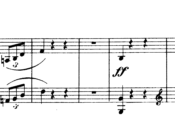Analysis
Contents
Prelude
SUMMARY:
Bars 1-8: Period I. Cadence in the Relative minor.
Bars 9-15: Period II. Modulatory.
Bars 15-18: Period III.
REMARKS:
This Prelude is founded upon the characteristic figure as seen in Bar 1 and affords another interesting example of the expansion of the simpler method of Arpeggios (as seen in Preludes I and II) into figures more definite and vivid; and demanding a larger amount of space to do their work effectively.
In Bar 4 there is a very strong Deceptive Cadence, the ear fully expecting the Tonic chord of F, is deceived by the 6th, flatened 4th and 2nd on its Supertonic, which leads to the key of the Relative minor.
Bar 10 is in Sequence with Bar 9. In bars 11-12 and 15-16 appear other Sequences with shorted steps.
With only two exceptions, shakes are placed upon all the longer notes (dotted minims/half notes) in this Prelude, in order to keep up the volume of tone.
Fugue
ANALYSIS:
ENUNCIATION SECTION:
Bars 1-4: Subject in Alto, ending on the first semiquaver (sixteenth note) of bar 4 [F major].
Bars 4-8: Tonal Answer in Treble. Counter-subject in Alto [C major].
Bars 9-13: Subject in Bass. Counter-subject in Treble [F major].
Bars 13-17: Episode I, modulating from F to C, and back.
Bars 17-21: Subject in Treble Counter-subject divided between Alto (Bar 18) and Bass (Bars 19-21) [F major].
Bars 21-25: Answer in Alto. Counter-subject in Treble [C major]
Bars 25-29: Subject in Bass. Counter-subject in Treble [F major].
Bars 27-31: Stretto I (incomplete). Subject in Alto. Counter-subject (last part) in Bass.
MODULATORY SECTION:
Bars 31-36: Episode II, modulating from F to D minor.
Bars 36-40: Stretto II (complete). Subject in Treble [D minor].
Bars 38-42: Subject in Alto [D minor].
Bars 40-46: Subject in Bass, followed by a Close in D minor [D minor].
Bars 46-50: Stretto III (complete). Subject in Bass [G minor].
Bars 48-52: Subject in Alto [G minor].
Bars 50-54: Subject in Treble [G minor].
Bars 55-56: Close in G minor.
Bars 56-63: Episode III, modulating from G minor to F major.
RECAPITULATORY SECTION.
Bars 64-68: Stretto IV (incomplete). Subject in Treble (made more florid) [F major].
Bars 65-68: Answer in Alto [F major].
Bars 68-72: Coda [F major].
SUMMARY:
Exposition: Bars 1-13.
Counter-exposition: Bars 17-31.
Episodes: Three.
Stretti: Four.
Coda: 68-72.
REMARKS:
- This Fugue has a “tonal” Answer, and would be styled as a “tonal” Fugue. The alternation in the Answer, for the sake of tonality, is made from the first note to the second.
- The Counter-subject disappears after the Counter-exposition, its place generally being supplied by a florid counterpoint.
- The Episodes are chiefly constructed from the Counter-subject.
- Episode I has the Counter-subject in the Bass part (transposed to the dominant C) with syncopations in the two upper parts.
- Episode II has its figures formed from the third bar of the principle subject in the two upper parts, the Bass having a more sustained figure, which commences with as descending sequence.
- Episode III has a new theme in the Alto (Bar 56) for imitation, mainly taken from the Counter-subject, to which the Treble responds at Bar 57, and this imitative work is continued for two more bars, the Bass meantime gently descending. At Bar 60, the bass takes up the theme proposed by the Treble in Bar 57.








